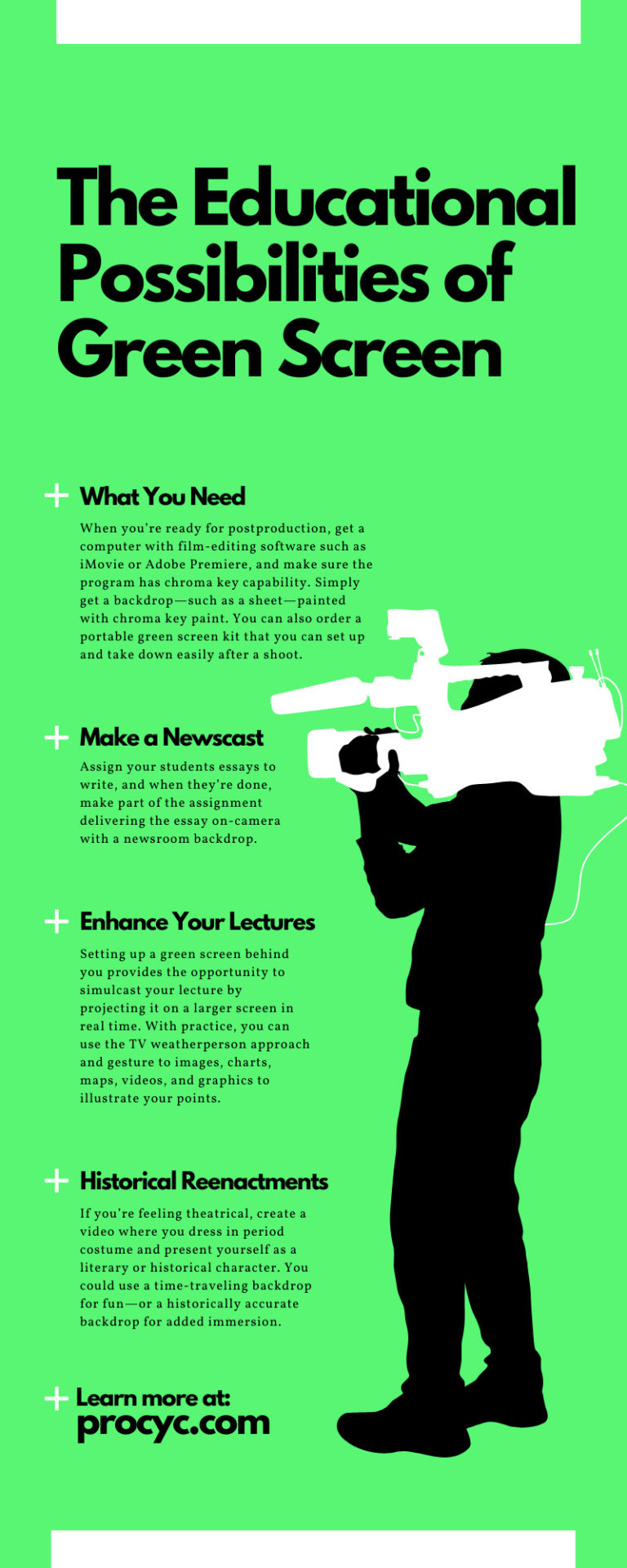Green screens aren’t just for movie special effects and television news programs. With a digital camera, a painted or portable green backdrop, a few props, and some computer trickery, you can create presentations and projects that will captivate your students. Make learning not just fun but also interactive and participative. Here are several of the educational possibilities of green screen you can include in your lesson plans.
What You Need
Before you start, there are a few basic supplies necessary for any green screen production. Check with your institution to see if these items are already available for your and your students’ use. You may even have studio facilities available and already prepared for green screen shoots. If not, you can easily use your smartphone camera—but make sure you get a tripod to hold it steady. When you’re ready for postproduction, get a computer with film-editing software such as iMovie or Adobe Premiere, and make sure the program has chroma key capability. Specifically, this means the ability to add background images and effects to footage filmed in front of a green screen.
Finally, you’ll need a green screen. Simply get a backdrop—such as a sheet—painted with chroma key paint. You can also order a portable green screen kit that you can set up and take down easily after a shoot. Whether you paint a sheet or use a green screen kit, make sure the surface is smooth and shadow-free to ensure you get the best result for your project.
Make a Newscast
Turning an essay into a newscast is fun, exciting, and creative. Assign your students essays to write, and when they’re done, make part of the assignment delivering the essay on-camera with a newsroom backdrop. If there’s time leftover and they have skill video-shooting and editing skills, give them the assignment of writing, producing, and sharing their own news report. It can be accompanied by background graphics and special effects. Such projects will kickstart students’ creativity.
Put on a Play
If you’re teaching students about plays, don’t settle for simply reading it out loud—be imaginative. Use a green screen to project a set behind the students, provide them with props, and let them act out the play. This is a great, super fun way to make plays come alive. When they get to partake in a play they made by themselves, they’ll feel a sense of pride and accomplishment. Perhaps doing such projects will even help the students develop a love of art, theater, or film!
Enhance Your Lectures
Lectures are a necessity—but students expect a little visual excitement these days. Setting up a green screen behind you provides the opportunity to simulcast your lecture by projecting it on a larger screen in real time. With practice, you can use the TV weatherperson approach and gesture to images, charts, maps, videos, and graphics to illustrate your points. Younger children will especially love learning this way. You can include interactive parts and props to make them part of the action as well.
Maintain Your Privacy
Online and at-home learning is here to stay. Whenever you need to conduct class from your home, a portable green screen kit can help you maintain a professional look and demeanor. Create a background you can implement when you’re teaching your lessons. A green screen also provides privacy and removes shots of your home life—people and pets passing by, furnishings and decorations—that can distract students. With the power of greenscreen, you can work anywhere and turn any room into a classroom.
Show-and-Tell
Little kids love show-and-tell and other “getting to know you” activities. Imagine how much more exciting it will be for them when there’s the power of greenscreen thrown into the mix. Sharing a favorite toy or story will be entertaining and enhanced for all when the images are projected behind your students. Projected videos will make possible things that could never happen in the classroom, like showing off a family pet or a recent trip to somewhere far away.
Travel Far Without Leaving Class
The internet offers a plethora of virtual tours of historical sites, museums and libraries, and other places that might be a bit too distant for a field trip. With a green screen, you can project and guide the class on a tour of faraway ruins, the frigid Arctic or sweltering rain forest, famous battlefields, and so many other places. Many great books and other works of art have been digitized and shared online, allowing you and your students to examine them even though the originals are a thousand miles away. Even if they never cross the threshold of the world’s great repositories of knowledge, you and your students can simulate the experience wonderfully by using a green screen.
Historical Reenactments
If you’re feeling theatrical, create a video where you dress in period costume and present yourself as a literary or historical character. You could use a time-traveling backdrop for fun—or a historically accurate backdrop for added immersion. When done properly, historical reenactments will not only entertain students but make history all seem a little more real. If you know your stuff, do a live broadcast from your chosen time period and have a Q&A session with your students afterwards when you answer questions in character. If you’re up for it and have the facts to back it up, offer your character’s opinions about society and technology. Make it clear that even if your subjects are long gone, history should be considered a living thing—because it is.
Final Tips
When you’re employing the educational possibilities of green screen, keep a few production ideas in mind. Never wear green during a shoot, or the images will appear on your clothing (unless you plan on doing this intentionally). Make sure you and the green backdrop are evenly lit and don’t allow shadows or folds to appear in the backdrop, otherwise the effects will be ruined. Have fun and help your kids keep learning!



